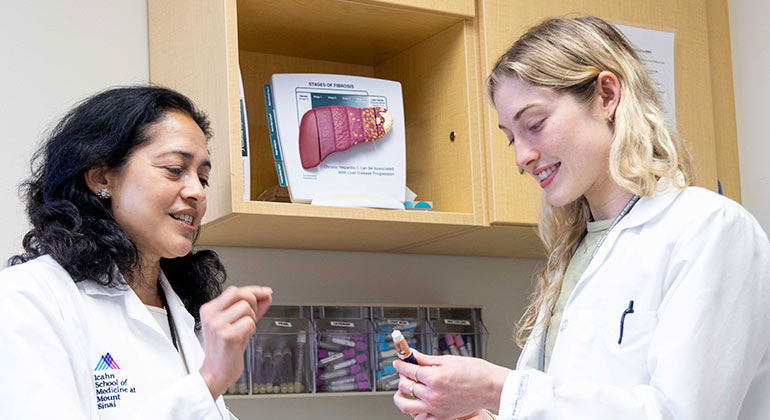Metabolic Dysfunction-Associated Steatotic Liver Disease, previously known as Non-Alcoholic Fatty Liver Disease

Mount Sinai Health System liver experts (hepatologists) offer highly specialized and multidisciplinary care for metabolic dysfunction-associated steatotic liver disease (MASLD). This disease is increasing in frequency due to more common occurrence of metabolic issues, such as obesity, diabetes, high cholesterol, and high blood pressure. Treatment focuses on addressing underlying drivers for metabolic dysfunction, common in both adults and children. Mount Sinai researchers were integral to bringing the first liver-directed, FDA-approved therapies to the market and continue to offer access to clinical trials to find additional promising new experimental treatments.
What Is Metabolic Dysfunction-Associated Steatotic Liver Disease
The liver plays a key role in processing nutrients in your diet and removing harmful substances from the body. When excess fat collects in the liver, whether through increased dietary fat and fructose intake or from changes in your body’s ability to digest fats, it can lead to this disease.
MASLD is a liver condition in both adults and children where excess fat accumulates around the liver. The disease is the most common liver disease in developed countries. As its name indicates, the disease is not due to alcohol use, but is often associated with metabolic syndromes such as:
- Diabetes
- High blood pressure
- High cholesterol
- Obesity
Chronic MASLD can produce mild symptoms, but if it evolves to the more progressive form of the disease known as metabolic dysfunction-associated steatohepatitis (MASH), wherein the fat now also causes liver injury and inflammation and progressive scarring, the symptoms can become more severe. If not treated, progressive scarring (fibrosis) can lead to cirrhosis, liver cancer, and possibly the need for liver transplantation.
Symptoms
You may not experience symptoms at the early stages of the MASLD. However, you may feel discomfort in your abdominal area due to the liver becoming enlarged or feel general fatigue.
Once the disease has progressed to an end stage of cirrhosis, or if liver cancer has developed, you may experience the following symptoms:
- Fatigue
- Jaundice or yellowing of skin and whites of the eyes
- Lack of appetite
- Muscle weakness
- Nausea
- Pain in the upper right side of the abdomen
- Weight loss
Diagnosis and Treatment
If you have risk factors for MASLD/MASH, such as type 2 diabetes, your doctor may calculate a screening test known as Fib-4. This is calculated using your age, levels of liver enzymes aspartate aminotransferase and alanine aminotransferase, and platelet count. You can also calculate this value by using online calculators like this one from MD+CALC. If you score is >1.3 you may need additional testing with a hepatologist.
Your doctor may also discover MASLD through routine blood tests or imaging, working collaboratively with the Pathology and Radiology Departments.
Our liver disease experts can confirm a diagnosis with the following tests:
- Blood tests: Detect abnormalities in the body
- CT scan: Computed tomography is a special X-ray that uses a computer to view the internal organs and may demonstrate fat in the liver
- Fibroscan: A specialized ultrasound machine that measures liver stiffness, a reflection of scarring, and fatty content of the liver
- Liver biopsy: Removes a tissue sample from the liver for analysis
- MRI: Magnetic resonance imaging uses a magnetic field and radio waves to view internal organs
- Ultrasound: An imaging modality that can look at internal organs and flow within blood vessels
If you have evidence of significant scarring, you may be eligible for FDA-approved therapies to treat MASH. We will also leverage a multidisciplinary approach to minimize your symptoms and the effects of metabolic conditions that cause the buildup of fat in your liver.
One important way to control the disease is by helping you lose weight with an exercise plan and dietary modifications. Suggested dietary changes include avoiding and limiting foods that have:
- High amounts of fructose syrup
- Saturated fats
- Trans fats
If your disease has progressed to cirrhosis or liver cancer, our liver specialists have the resources to treat these conditions. In collaboration with Mount Sinai’s Diabetes Center and our weight loss and bariatric surgery teams, we offer a multidisciplinary approach to managing advanced MASLD.
For the most advanced liver disease and liver cancer, we also provide referrals to Mount Sinai specialists through our:
- Recanati/Miller Transplantation Institute for liver transplantation
- Interventional Radiology team
- Liver Cancer team
Metabolic Dysfunction-Associated Steatohepatitis
Some patients with metabolic dysfunction-associated steatotic liver disease may have a more severe form of the disease known as metabolic dysfunction-associated steatohepatitis (MASH). This is formerly known as nonalcoholic steatohepatitis (NASH). This disease rarely has symptoms but can lead to cirrhosis and liver cancer.
Our specialists diagnose the disease by evaluating abnormal areas in the liver, which may have been found in imaging (ultrasound, CT scans, and MRIs) or during certain surgeries, such as gallbladder surgery or weight-reduction surgery. For example, about one-third of patients who undergo weight reduction surgery have MASH.
Diagnosis of the disease is important so that we can intervene to reduce the risk of it progressing. Your treatment plan may include making changes to your diet and controlling coexisting metabolic syndrome conditions such as diabetes or high cholesterol. We also offer access to clinical trials of new treatments.
Medication: In March 2024, the U.S. Food and Drug Administration approved the first therapy for MASH, resmetirom. You take it by mouth once a day. The drug is indicated for those who have some fibrosis/scarring of the liver but do not yet have cirrhosis.
Mount Sinai conducts clinical trials and, as a patient, you may enroll.
For more information on clinical trials for MASLD/MASH, call: 212-824-7931